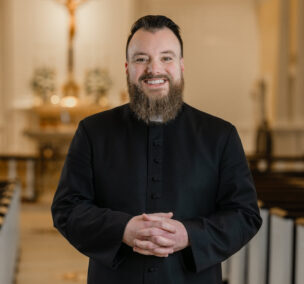Dear Brothers and Sisters in Christ,
Over the last few weeks, we’ve experienced some problems with two important systems in the Church: heat and sound. Fortunately, we have been able to resolve both issues, and I hope you find the temperature of the Church pleasant and the volume coming through the speakers sufficient. While building maintenance and technology is a necessary concern, I cannot help but think about the intersection of our spirituality, liturgy, architecture, and technology in all of this.
Churches have been around far longer than electronic amplification systems. A fascinating part of the logic of ecclesiastical architecture involves the selection of certain building materials and styles in service of the worship offered in the building. Marble floors in a church with stone walls and vaulted ceilings doesn’t just look cool, it also creates an acoustically resonant space. Choir lofts are found the world over so that the voices of those singing are physically elevated above the crowd, allowing their chant to fill the air and call to mind the heavenly singing of the choirs of angels. In churches around the world that predate the colonizing of North America, you will find pulpits that seem out of place outside of the sanctuary and strangely covered by a little roof. But they were built in strategic locations, with a wooden canopy – a sounding board – so that the preacher’s voice could project and fill a large space. Microphones are, in the grand scheme of the Church’s history, still a brand new technology. These architectural features, of course, also predate our modern liturgy, which, in its turn, is also relatively new in the context of 2000 years of tradition. Traditionally, the principal prayers of the liturgy were chanted – the voice tends to carry differently when singing. But significant prayers, including the entire Eucharistic prayer and consecration of the bread and wine, were once prayed in a near whisper. These were not simply practical considerations, but spiritually significant actions. Remembering them in our modern context and with modern means of amplification can help us keep our focus as we celebrate the liturgy today.
What then is the focus of the Church’s liturgical prayer? The prayers of the Mass are, almost entirely, addressed to God the Father. Whether the prayer is audible or not (either deliberately or not), all who pray at Mass are invited to direct their attention and their prayer to the worship of God. When we can hear, we are able to make the prayer our own. If we cannot hear, we are, just the same, invited to offer our worship and our attention to God. If I go to a Mass celebrated in a language I do not speak, I might be able to hear the prayers being said, but the fact that I cannot understand does not diminish my capacity to participate in the Mass, because my participation is not primarily a vocal exercise but an exercise of the heart. To fruitfully participate in Mass, the most essential thing is the focus of mind and heart on the God who gathers us for worship. Participation is helped by being able to hear, but can also be helped when inaudibility demands that we enter into silence. With gratitude that we can hear, let us also appreciate the gift of silence. With gratitude that we can understand, let us also appreciate that our worship allows us to confront and contemplate mystery. With gratitude for the technology that makes our experience of worship more comfortable, let us also appreciate that our periodic discomfort invites us to be united to our Lord in His suffering, to the poor and the sick, and that we are able to make our lives and our worship a gift of love to the Lord.
Peace,
Fr. Sam


